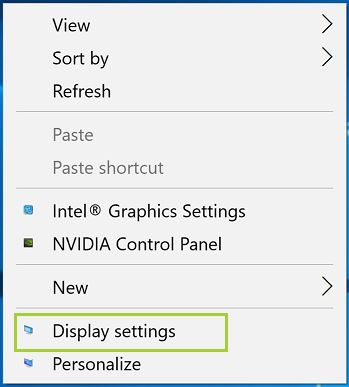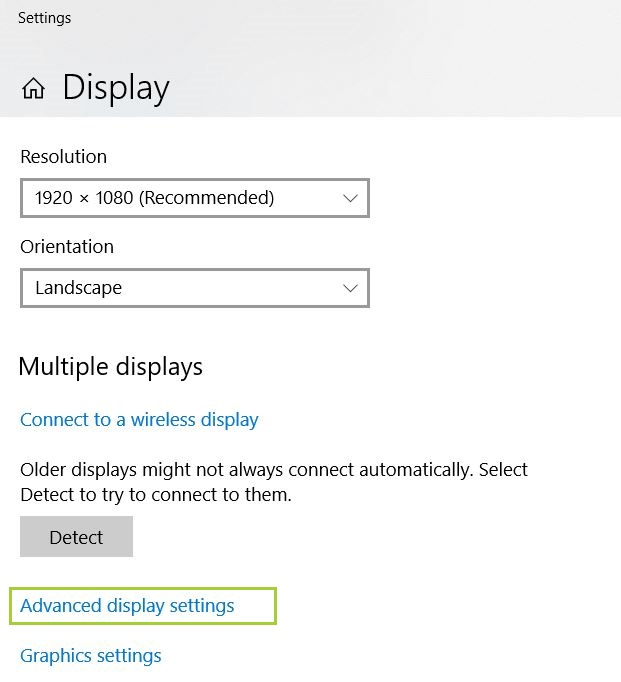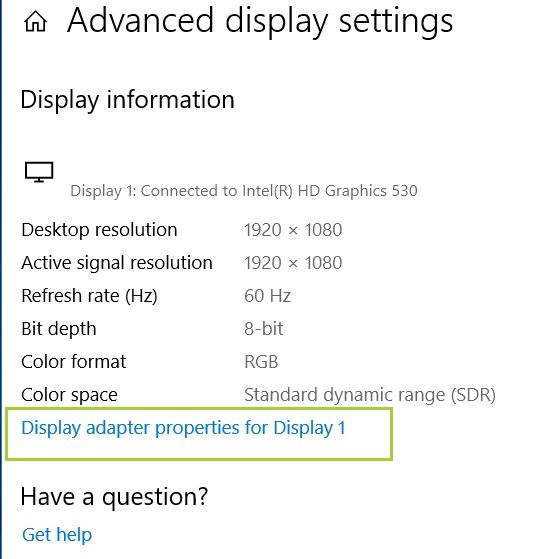Environment
Operating System
Click or the topic for details:
How much graphics memory does my computer have?
The integrated Intel® processor graphics hardware doesn't use a separate memory bank for graphics/video. Instead, the Graphics Processing Unit (GPU) uses system memory. The Intel® graphics driver works with the operating system (OS) to make the best use of system memory across the Central Processing Units (CPUs) and GPU for a computer’s current workload.The following steps may be used to view a Windows® 10 computer’s graphics memory configuration:
- Switch to the Windows* Desktop
- Right-click on a blank area of the desktop and select Display settings.

- Click Advanced display settings.

- Click Display adapter properties.

- The total available graphics memory is listed on the Adapter tab under Adapter Information.

| Note | The reported Shared System Memory is not an ongoing reservation of system memory. It's simply the limit of how much system memory the OS will allow graphics to use at a given time, on the given platform. |
| Note | By default, the Intel graphics driver will report 128 MB of fictitious Dedicated Video Memory for compatibility with applications that don’t correctly comprehend a fully unified memory architecture. See Dedicated Memory Reporting for more information. |
What is the maximum amount of graphics memory or video memory my computer can use?
The table shows the maximum graphics limits supported by the Intel® HD Graphics Driver depending on your processor. The actual maximum graphics memory limit reported by Windows can vary. The memory limit is dependent on non-Intel-controlled factors—for example, available system memory, BIOS, or system settings. For more detail on how Windows handles memory management, see Microsoft documentation for Graphics Memory Reporting through WDDM.| Intel® Processor | Maximum Graphics Memory1 on Windows® 10 and Windows 11* |
| Intel® Graphics for Intel® Core™ Ultra Processors (Series 2) | Limited by OS to one-half of System Memory |
| Built-in Intel® Arc™ Pro GPUs with select Intel® Core™ Ultra H-series Processors2 | Limited by OS to one-half of System Memory |
| Intel® Arc™ Graphics for Intel® Core™ Ultra Processors (Series 1) | Limited by OS to one-half of System Memory |
| Intel® Graphics for Intel® Core™ Ultra Processors (Series 1) | Limited by OS to one-half of System Memory |
| Intel® Iris® Xe Graphics | Limited by OS to one-half of System Memory |
| Intel® UHD Graphics 710 | Limited by OS to one-half of System Memory |
| Intel® UHD Graphics 730 | Limited by OS to one-half of System Memory |
| Intel® UHD Graphics 750 | Limited by OS to one-half of System Memory |
| Intel® UHD Graphics 770 | Limited by OS to one-half of System Memory |
| Intel® UHD Graphics for 11th Gen Intel® Processors | Limited by OS to one-half of System Memory |
| Intel® UHD Graphics for 10th Gen Intel® Processors | Limited by OS to one-half of System Memory |
| Intel® UHD Graphics | Limited by OS to one-half of System Memory |
| Intel® Iris® Plus Graphics | Limited by OS to one-half of System Memory |
| Intel® UHD Graphics 620/630 | Limited by OS to one-half of System Memory |
| Intel® UHD Graphics 600/605 | Limited by OS to one-half of System Memory |
| Intel® Iris® Plus Graphics 640/650/655 | Limited by OS to one-half of System Memory |
| Intel® HD Graphics 610/615/620/630 | Limited by OS to one-half of System Memory |
| Intel® Iris® Pro Graphics 580 | Limited by OS to one-half of System Memory |
| Intel® Iris® Graphics 550/540 | Limited by OS to one-half of System Memory |
| Intel® HD Graphics 530/520 | Limited by OS to one-half of System Memory |
| Intel® HD Graphics 515 | Limited by OS to one-half of System Memory |
| Intel® Iris® Graphics 6200/6100 | Limited by OS to one-half of System Memory |
| Intel® HD Graphics 6000/5500 | Limited by OS to one-half of System Memory |
| Intel® HD Graphics 5300 | Limited by OS to one-half of System Memory |
| Intel® Iris® Pro Graphics 5200 | Up to 2048 MB |
| Intel® Iris® Graphics 5100 | Up to 2048 MB |
| Intel® HD Graphics 5000/4600/4400/4200 | Up to 2048 MB |
| Intel® HD Graphics 4000/2500 | Up to 1792 MB |
| Intel® Celeron® Processors 900/1000/G1000/2000/J1000/N2000/N3540/N2940/ N2840/N2808/N3000/N3050/N3150 Series with Intel® HD Graphics | Up to 1792 MB |
| Intel® Pentium® Processors 2000/G2000/G2100/3000/G3000/J2000/N3000/G3460/ G3450T/G3250/G3250/G3250T/N3700 Series with Intel® HD Graphics | Up to 1792 MB |
| Intel Atom® Processor Z2700/E3800/Z3700/N3000/N3050/N3150/N3700 | Up to 748.5 MB |
1The actual amount of maximum graphics memory on your computer can be less than the amounts listed in the table. The actual amounts greatly depend on your computer configuration. The best place for obtaining information about your computer configuration is from the computer manufacturer. Your computer manufacturer can alter features, incorporate customizations, or make other changes that limit or reduce the actual maximum graphics memory.
2Intel® Arc™ GPUs only available on select H-series Intel® Core™ Ultra processor-powered systems with at least 16 GB dual-channel memory. OEM enablement required. Check with OEM or retailer for system configuration details.